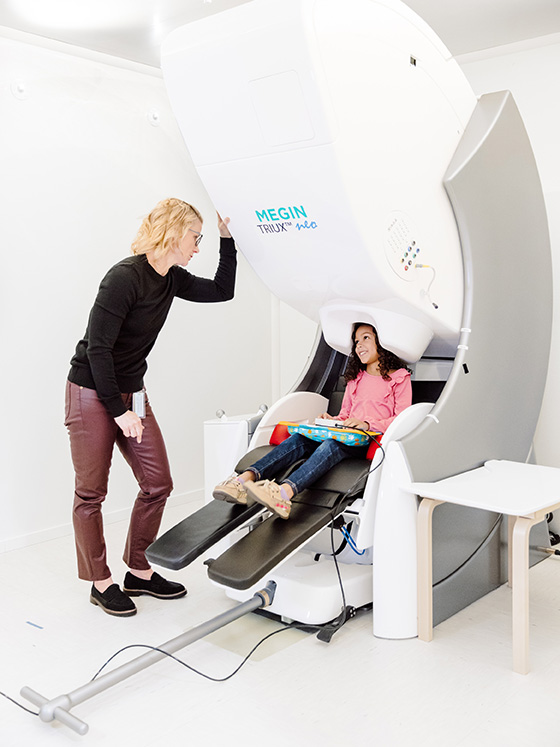Harnessing Imaging Tech to Understand Brain Development
By Elizabeth Heinrichs-Graham, Ph.D.
Our brains are remarkable organs. They detect and learn connections between people, places, and things, and control how we think, feel, and behave. Our ability to sense, perceive, learn, and do are all a function of how our brain adapts to the world around us. For example, look at how much a child learns in the first years of life: how to crawl, walk, and run; how to communicate and interact with parents, siblings, and friends; how to think and formulate opinions about the world; the list is endless. As an ever-adapting organ, our brains are sensitive to our cumulative life experience, including what we see, hear, feel, and learn throughout our lifetime.

Brain Changes with Auditory Experience
Children with hearing differences are at a heightened risk for speech, language, and other cognitive delays compared to children with typical hearing. This is true in both children who are deaf and in children with mild-to-severe hearing loss (i.e., children who are hard of hearing).
However, there is also a lot of variability in outcomes, such that some children who are hard of hearing perform at or above the levels of children with normal hearing, while others fall significantly behind. Separately, children with hearing differences also have a fundamentally different cumulative auditory experience than children with typical hearing, simply due to differences in what and how they hear the world. It makes sense that differences in auditory experience would lead to differences in how a child’s brain responds and learns, given how malleable and adaptive our brains can be.
Emerging work suggests that, even when children who are hard of hearing perform as well as children with typical hearing on a given cognitive (e.g., memory, rule-matching) or language task, brain activity during the performance of these tasks is significantly different, where children who are hard of hearing use additional brain regions to perform a task that children with typical hearing do not use. These alterations in brain activity also scale with the amount of auditory experience an individual has, such that children who wear their hearing aids the most have brain activity that looks the most like children with typical hearing. Finally, brain activity in these children scales with behavioral and academic performance measures. Taken together, these studies suggest that neuroimaging may hold promise in helping us understand the underlying brain processes that give rise to the variability in behavioral and academic outcomes commonly seen in children with hearing loss.
Research Opportunities Related to Hearing Differences and Brain Development
Researchers at Boys Town National Research Hospital’s Institute for Human Neuroscience are hoping to take advantage of a unique neuroimaging device called magnetoencephalography, or MEG, to help us understand how differences in hearing experience relate to how our brain learns and develops. MEG uses advanced technology to noninvasively record brain activity in real-time as a person is performing a task, such as trying to remember letters, matching words to pictures, or completing sentences, or even when they are sitting quietly and not doing anything. Through this study, researchers are hoping to understand how differences in a child’s cumulative auditory experience (for example, how much hearing loss a child has, how often they wear their hearing aids, and how successful their hearing aids are at restoring access to speech) relate to changes in the brain dynamics that underlie language and cognitive function through development, with the idea that this information will help us understand how the brain uses what we hear to learn and adapt in the noisy, complicated world we live in. This research approach is unique in that it can help us understand the underlying brain processes that occur in real-time while a child is making a cognitive decision before they respond. This stands in contrast to behavioral studies that, while very valuable in their own right, depend on end-point behavioral measures like accuracy or reaction time, which only tell us what the child’s decision was and not the underlying process. Information about the underlying brain processes can be used not only to help us understand how our brain responds to differences in auditory experience, but it will also help inform which aspects of hearing technology and education would best help children with hearing differences thrive.
If your family would like to participate in the brain imaging studies described above, please sign up at https://www.instituteforhumanneuroscience.org/participate. Participants will receive up to $170 for their participation, and nationwide travel (flights and/or mileage), hotel, and accommodations for participants and a parent/guardian are included as part of the study. ~
Editor’s note: Dr. Heinrichs serves as Director of the Cognitive and Sensory Imaging Laboratory at the Institute for Human Neuroscience at Boys Town. Research opportunities are listed on the Hands & Voices website: https://www.handsandvoices.org/resources/research_opps.htm.
H&V Communicator – Fall 2024